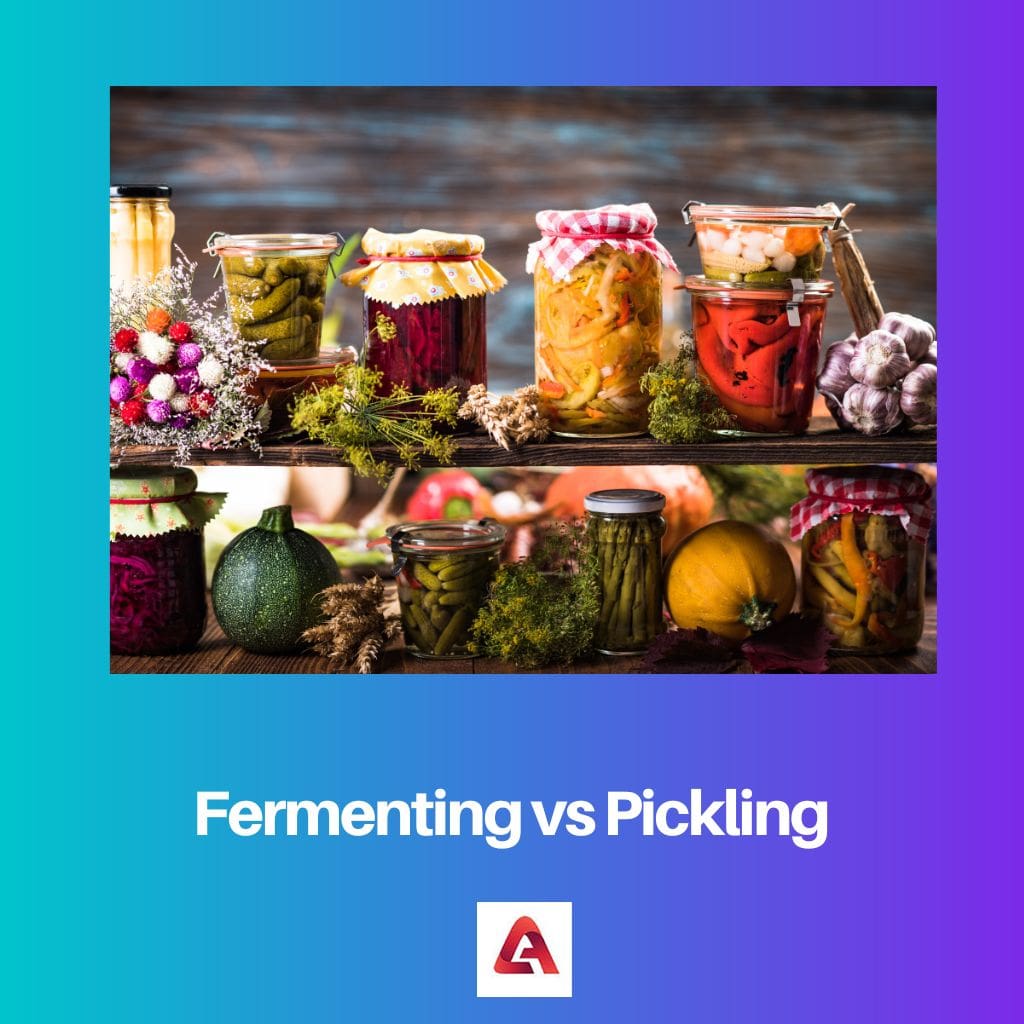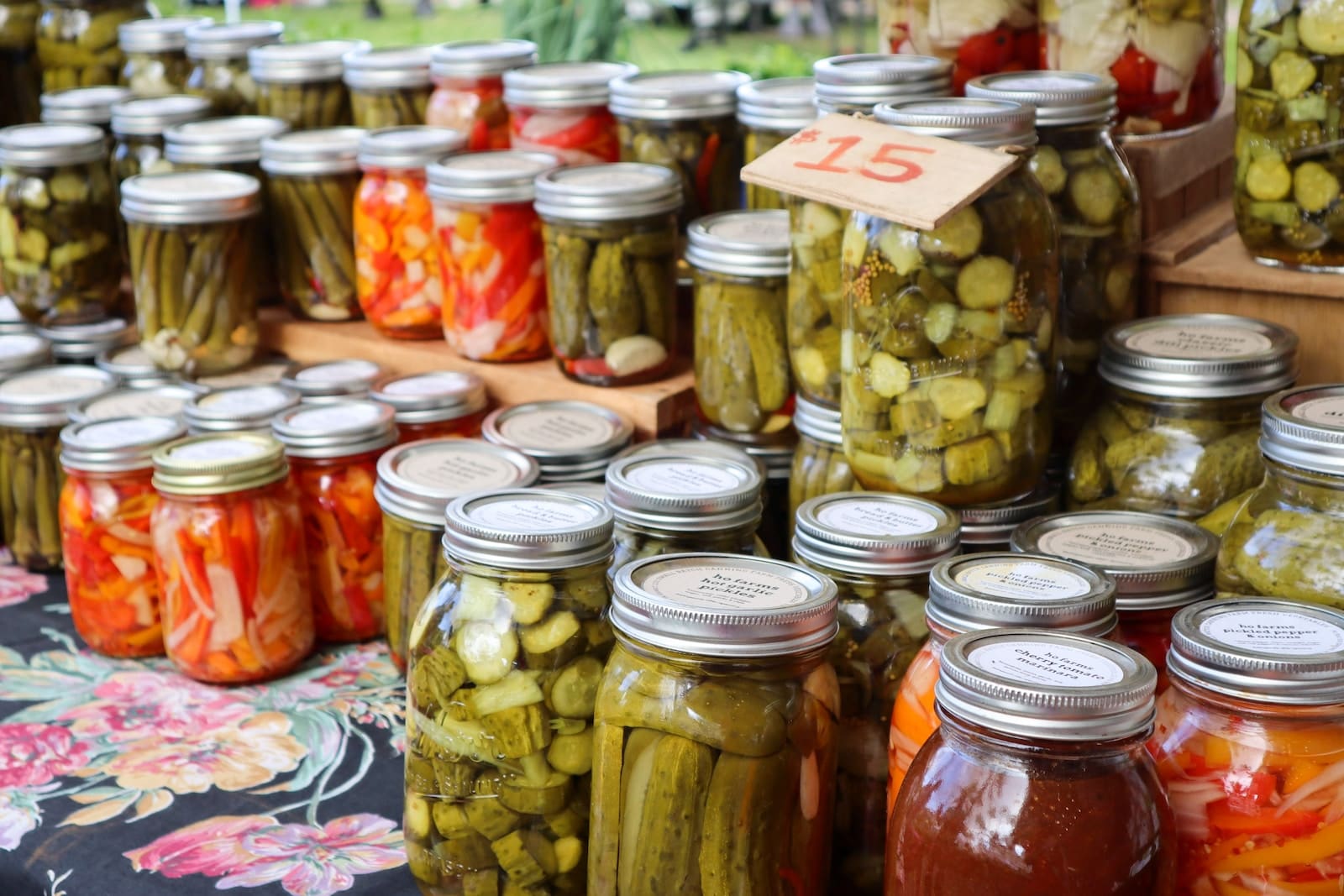Pickling and fermenting are two forms of food preservation techniques that bring out even the tiniest of flavors. They are two of the earliest known ways of food preservation, yet they are frequently confused.
Pickled and fermented foods are confused because they are bright, tangy, and full of tang. Pickled and fermented foods are created in slightly different ways, despite certain similarities.
Key Takeaways
- Fermenting is a natural process that preserves food through the action of beneficial bacteria, while pickling involves preserving food in an acidic solution, such as vinegar.
- Fermented foods contain live probiotics that promote gut health, whereas pickled foods may not have the same probiotic benefits.
- Fermented foods include yogurt, sauerkraut, and kimchi, while pickled foods include pickles, pickled onions, and pickled peppers.
Fermenting vs Pickling
The difference between Fermenting and Pickling is that Fermenting is a procedure that is obtained when yeast, microorganisms, bacteria breaks down the food components into gases, organic acids, alcohol, etc. After the procedure, the food grasps a bit of sour taste in it due to the chemical reaction. On the other hand, Pickling is the procedure where different food items are conserved after putting them in a salt solution or brine solution because of which later the food tastes sour and tangy.

Fermenting is the chemical process of converting living organisms contained in carbohydrates and glucose (such as starch or sugar) to alcohol or acids.
Fermentation is an anaerobic process, which means there is little to no oxygen available during the fermentation process.
Fermenting causes a desirable alteration in the structure and flavor of the food, as well as the production of tonnes of beneficial probiotics.
Pickling is the process of preserving foods in an acidic liquid. Rapid pickling requires water, vinegar, pickling salt, and optional pickling spices or aromatics (fresh herbs, citrus rinds, and garlic) to enhance the flavor of your pickled goods.
If the user is using the Lactic Acid Fermentation method, the brine should be free of acid and only contain water, salt, and any other flavorings they like.
Comparison Table
| Parameters of Comparison | Fermenting | Pickling |
|---|---|---|
| Definition | Fermenting is the breakdown of food components (such as sugars and carbohydrates) by microorganisms such as bacteria and yeast into other products such as organic acids, gases, and alcohol. | Pickling is the process of preserving food by immersing it in brine (salty water) or an acid such as lemon juice or vinegar. |
| Preservation | Through the help of bacteria, yeast, etc | Salty solution or acid |
| Environment Required | Clean | Sterile |
| Probiotic | Encourages to grow bacteria | Kills all the pathogens present |
| Flavor | Complex | One-note |
| Nutrients | Adds necessary nutrients in the process | No such procedure |
| Speed | Slow | Fast |
| Shelf Life | Less | More |
What is Fermenting?
Fermenting is the breakdown of food components (such as sugars and carbohydrates) by microorganisms such as bacteria and yeast into other compounds such as organic acids, gases, or alcohol.
Food can be preserved for a longer amount of time with these goods. Fermentation also provides food its distinct flavor, aroma, texture, and appearance.
Fermentation is used to make wine, cheese, yogurt, miso, sauerkraut, kimchi, and kombucha, among other foods.
When natural bacteria-containing fruits and vegetables are deprived of oxygen, the growth of spoilage-causing germs is repressed and inhibited.
During fermentation, natural bacteria in food convert carbohydrates and sugars in the meal to an acid, creating an ideal environment for food preservation. This chemical process gives fermented foods their sour tang.
Many fermented foods begin with brine. That is why pickling and fermentation are confused. Sauerkraut, for example, is created by packing cabbage with salt and allowing it to ferment.
Furthermore, while kimchi is created with components such as cabbage, radish, garlic, anchovy, and chili, salt is required.

What is Pickling?
Pickling is the process of preserving food by immersing it in brine (salty water) or an acid such as lemon juice or vinegar. Fruits and vegetables are picked.
Pickling food is mostly used to enhance its shelf life. The flavor and texture of the food are also affected by the pickling procedure. Pickling involves the use of heat, which aids in the destruction and suffocation of microorganisms.
Pickling can be divided into two types: clear pickle and sweet pickle. A clear pickle is a traditional British method of preserving vegetables and fruits that dates back centuries.
Pickled vegetables and fruits are frequently left uncooked and intact. This veggie is then seasoned with vinegar, salt, and sugar, as well as additional herbs, spices, and honey.
Lightly cooked veggies are combined with sweet vinegar to make sweet pickles. Typically, the vegetables are sliced into large chunks. Spices such as ginger and cloves are also used by certain individuals to add flavor.
Fermentation occurs in some pickled foods as well. Pickled foods that are not fermented, on the other hand, do not have the probiotic and enzymatic benefits of fermented foods because they are heated for sterilization and preservation.

Main Differences Between Fermenting and Pickling
- The fermenting process can be stated as the procedure where microorganisms, bacteria, or yeasts break down the food particles into some other products like – alcohol, organic acids, gases, etc. Whereas comparatively, on the other hand, the process of pickling can be described as the procedure of conserving the food material by putting them in any brine solution or acid solution like vinegar or lemon juice.
- The preservation method used in fermenting is the microorganisms, yeasts, bacteria, whereas comparatively, on the other hand, the preservation method used in the pickling process is the acid solution (like vinegar or lemon juice) or salt solution.
- The surrounding environment required for the fermenting process must be clean, whereas comparatively, on the other hand, the surrounding environment for the pickling method must be sterile.
- The presence of probiotics (alive) in fermenting process helps in encouraging the growth of good bacteria, whereas comparatively, on the other hand, the presence of probiotics during the procedure of pickling kills all the present pathogens.
- The flavor of any fermented food tastes much more complex, whereas comparatively, on the other hand, the flavor of any pickled food has a one-note taste.
- During the procedure of fermenting, the microorganisms add up the extra beneficial nutrients in the product, whereas comparatively, on the other hand, in the procedure of pickling, this phenomenon is absent.
- The process of fermenting is much slow and steady, whereas comparatively, on the other hand, the process of pickling is quite a fast process.
- The shelf life of fermented food is very minimal, whereas comparatively, on the other hand, the food can be preserved for much longer through the pickling process.
